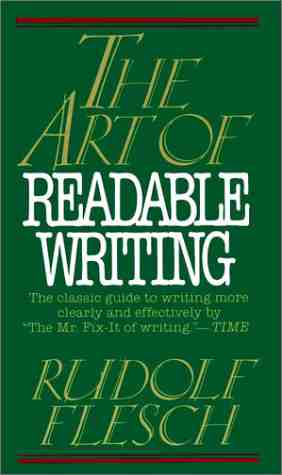Time to think as a writer’s technique
Is taking time to mull over your topic one of the best things you can do to succeed as a writer?
The following quote from Rudolf Flesch’s chapter on “The Shape of Ideas” in The Art of Readable Writing set me to thinking:
Every professional writer knows that this period of just-sitting-and-thinking between legwork and outline is the most important part of the whole writing process.
I know that I write better when I let the ideas marinate in my head before I write. Distance from the content gives me perspective. As Flesch notes in a different chapter, “… the unconscious mind is so much better at combining ideas in a novel way. It puts together things that we would never put together in our ‘right mind.’” However, simply walking away from the material may not be enough. In “The Shape of Ideas,” Flesch suggests two ways to jumpstart your thinking.
1. Tell someone
Flesch suggests that you talk through your topic with a member of your target audience. Your goal should be to figure out one sentence or phrase that captures your main point. If you do this, “Everything else will arrange itself around this one sentence or phrase almost automatically,” says Flesch. In other words, the sentence becomes like a “elevator speech” for your writing.
I think talking things through with a member of your target audience is helpful because they add a perspective you lack. They’ll tell you what really interests them. They’ll also cue you into words or concepts that you need to explain better.
2. Write about a “typical person” or common theme
“Whenever you’re writing about a group or an organization, … focus on a typical member of the group. Start by describing him (or her) and go on from there,” suggests Flesch. You can use this technique to organize your thoughts. For example, you could write about a typical member of a 401(k) plan. Flesch warns that you should be careful to pick someone who’s truly typical, instead of a flashy outlier.
If you’re not writing about a group, look for some other common denominator, suggests Flesch. It could be an event that’s a turning point or some sort of theme
My take on finding the key idea
If you lack the time to mull over your topic—and if Flesch’s ideas don’t apply—what can you do?
My favorite approach is to draw a mind map of my ideas for the piece, whether it’s a blog post, white paper, or even a book chapter. Mind mapping is a visual, non-linear brainstorming technique that I discuss extensively in my book, Financial Blogging: How To Write Powerful Posts That Attract Clients and in posts on this blog, such as Photo + Mind Map = Blog Inspiration. I felt as if mind mapping saved my sanity when I wrote complex articles with a dozen or so sources for trade magazines. The birds-eye perspective offered by mind maps helped me find patterns in the apparent chaos of data.
If mind mapping doesn’t appeal to you, try freewriting, which I also discuss in Financial Blogging. Basically, you write for a limited period—perhaps 10 minutes—about whatever pops into your head on your topic. Then, you pause to analyze what you’ve written. This should help you to find themes.
What works for YOU?
Different techniques work for different people. If you’ve found a great technique that I haven’t mentioned here, please share it.
I like it when people share things with me. I discovered Flesch’s book because Doug Tengdin (@tengdin) told me about it. Thanks, Doug!





